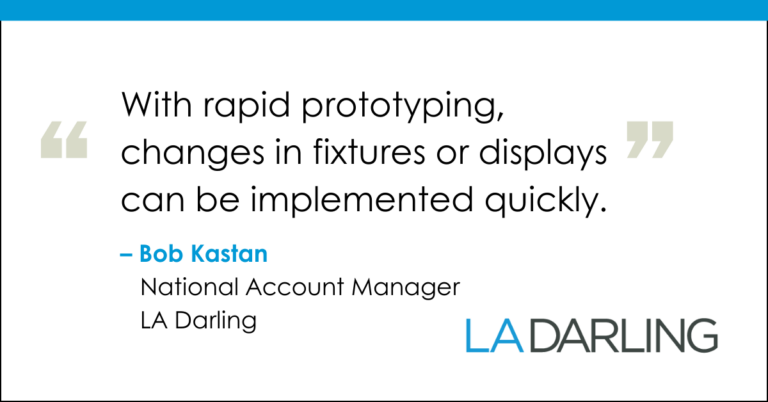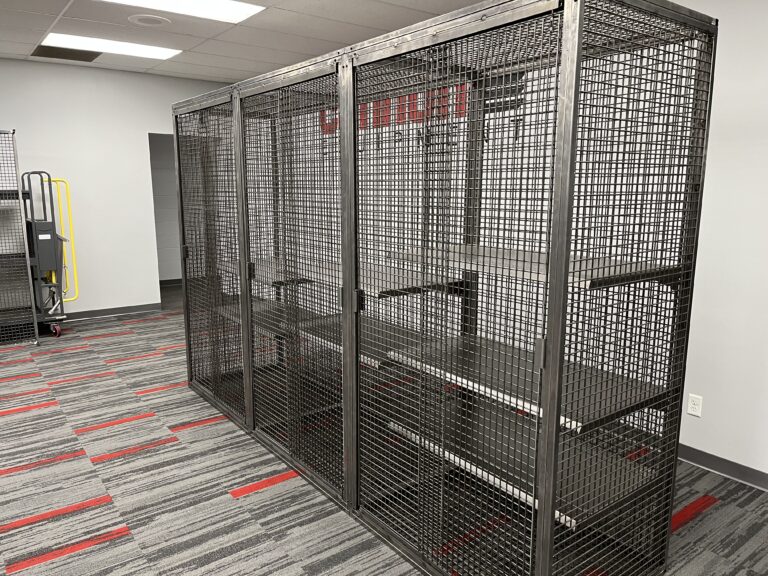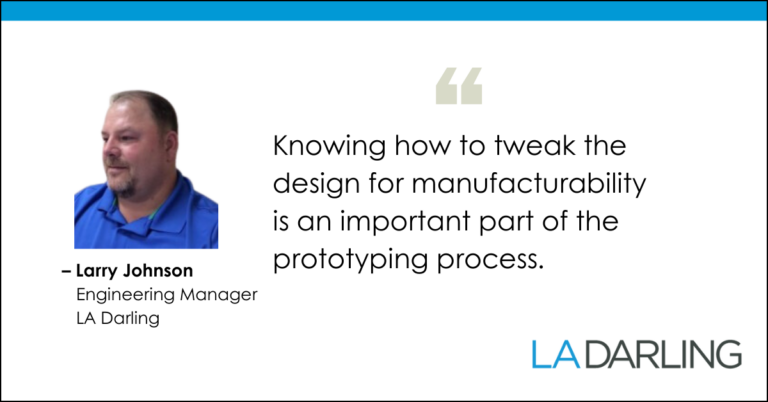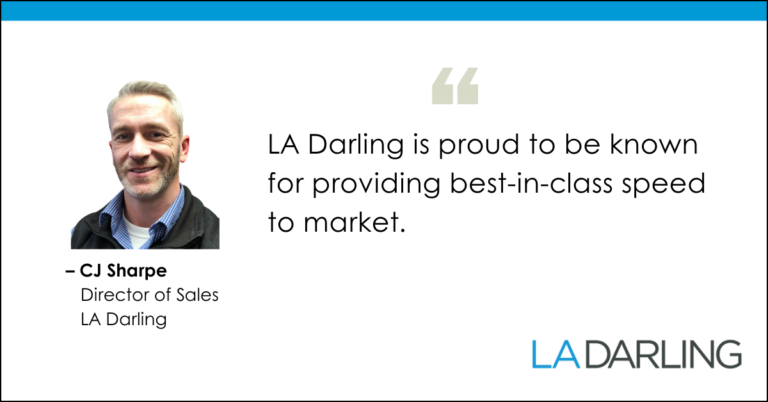When you need a custom retail fixture or display, you need it fast. Rapid prototyping is the key element that accelerates every step of the process to help you achieve the speed you need.
How does rapid prototyping work, and what advantages does it offer?
In this post, experts from L.A. Darling share their insights on how rapid prototyping gives you an edge in decision making, speed to market, and supplier benchmarking.
This short video gives a quick overview of rapid prototyping benefits covered in the post.
What is rapid prototyping?
Prototyping is simply the process of creating a sample or full-size model of the component or complete product that will be produced in a large-scale production run. It provides a true north for accurate communications and helps identify and answer practical questions about form and function.
While building a prototype does take time, L.A. Darling clocks some of the fastest turnaround rates in the industry, most often ranging from two days to two weeks.
This speed reflects the work of technicians with decades of experience and in-house availability of a full complement of fabrication, machining, and painting systems. And the material suppliers L.A. Darling chooses to work with are largely domestic.
For producers whose supply chain involves overseas manufacturing, prototyping turnaround must also include additional time for transportation. If additional iterations are necessary, the effect of turnaround time is multiplied.
What makes rapid prototyping beneficial to your retail operation?
Rapid prototyping can unlock a chain of benefits for your organization. Here are a few examples.
Ensures clear, consistent, and accurate communication
Your first audience is internal: your own leadership team. Everyone needs to share the same clear vision, especially stakeholders who are less comfortable visualizing the finished product from a sketch or line drawing.
A physical example brings the product to life so that your team can verify the concept and its functionality before taking the next steps. That same clear standard can be communicated more accurately to suppliers during the bid process.
Your prototype then becomes the source of truth for reference and a common understanding of expectations. Merchants, your procurement team, and potential suppliers, all can readily grasp construction requirements and see how the colors, finishes, logos and brand elements will work.
Helps you reach decisions more quickly
Business moves at the speed of decisions. Miscommunications are avoided and decisions are easier to make when everyone involved is working with one physical standard sample as a reference.
Gaining buy-in more quickly and confidently gives you an edge in responding to the needs of brands and merchants you work with so you can meet launch dates and move forward without unnecessary delays.
As you progress toward full production, testing a realistic prototype adds another layer of confidence.
Lets you react quickly to changing market needs
Your needs can change at any time, for a new store or product launch, an unexpected deadline, changes in services delivered, or in response to thefts. Custom security cases offer an example.

“With rapid prototyping, changes in fixtures or displays can be implemented quickly, such as when theft spikes and merchandise needs the extra protection of locking display cases,” says Bob Kastan, National Account Manager at L.A. Darling. “Theft patterns can increase suddenly, and design changes need to keep pace.”

What’s involved in the prototyping process for retail fixtures?
Prototyping converts a concept on paper into a three dimensional working sample that can be manufactured efficiently. At L.A. Darling, the process includes three broad stages.
1. Design input: Engineering drawing or rough sketch becomes initial design
Your design might still be in the conceptual stages, but more often, prototype design begins with a drawing. That could be anything from a detailed line drawing prepared by your engineering team to a simple sketch on a napkin.

The prototype is the first stage that lets you determine both if the fixture or component can be manufactured and if it can work.

“It’s possible for designers to create drawings of an item that can’t be manufactured,” says Larry Johnson, L.A. Darling Engineering Manager. “Knowing how to tweak the design for manufacturability is an important part of the prototyping process.”
2. Sample construction: Accuracy in materials and function leads to an effective sample
While a sample or model could be made of cardboard or other convenient substitute material, a prototype constructed using the materials, finishes, and dimensions intended for the manufactured item gives a clearer picture of the look, feel and operation of the proposed item.
Along with ensuring the manufacturability of the design, L.A. Darling’s sample technicians produce prototypes that are not only operational, but complete with millwork, paint, and finishing details typically within the same length of time as others could produce a cardboard version.
This speed and attention to detail applies to every project whether it’s a fixture accessory, an entire gondola, security case display system or any other type of custom retail fixture.
3. Operational performance: Testing and quality control ensure reliability
Finished samples are tested in-house to meet design requirements. Security cases and displays, such as those constructed of woven steel wire, take a beating as part of their evaluation to assess their performance against thieves.
Once custom security cases have survived L.A. Darling’s in-house tests, they’re ready to be subjected to your own rigorous testing to identify any areas that require special attention. Our guide to security case features offers more detail on the variety of case structures and component options available.
Rapid prototyping is an indicator of supplier qualifications
The supplier characteristics that make consistent, responsive, rapid prototyping possible often reflect higher overall performance as a custom display manufacturer. Look for these signs.
Domestic prototyping to support turnaround and responsiveness
The process and timing involved in generating prototypes takes longer when suppliers are working with overseas producers because of extended transportation and communications. This time lag could mean the difference between meeting or missing launch dates and deadlines.
L.A. Darling largely relies on domestic production that taps manufacturing facilities in the same region. This makes it possible to respond within days to requests and produce a prototype usually within two weeks.

“Timing and speed to market are absolutely critical,” notes C.J. Sharpe, Director of Sales. “L.A. Darling is proud to be known for providing best-in-class speed to market.”
Fully equipped prototype lab for accurate sample construction
Skill and experience make all the difference. Johnson notes that each of the technicians on the sample team at L.A. Darling has more than 40 years of experience. The lab is equipped with a full range of fabrication and machining equipment, for handling all types of fixture materials including millwork, interior painting and finishing. When full production kicks in, suppliers are all located within a geographically close region for speed.
High tech prototyping capabilities to deliver added services
Taking prototyping to the next level, what additional related services can your supplier provide? Some of the extras you might like to see from your supplier include these options that L.A. Darling makes available.
Pilot store installation
Before you get a store or chain of stores up and running, you may need to see a pilot installation including a full set of fixtures for the store. L.A. Darling is one supplier that can readily meet requirements like these. If the number of pilot stores is small, up to perhaps 10 stores, all components and fixtures often may be made in the prototype facility.
Immersive experiences and visualization
In conjunction with, or in place of, a detailed prototype or physical example of the fixtures needed for your store construction, immersion and visualization methods offer another layer of experiential examination. L.A. Darling offers two types of simulation experiences.
The Cave is an immersive experience for visualizing a store build–a full 3D world with all the layers of products and items needed.
Rapid rendering of a full store or virtual walkthrough is available, produced by a European design house as part of L.A. Darling’s overall corporate resources.
Rapid prototyping delivers more than speed to market
Rapid prototyping leads to faster decisions, faster iterations, and faster production times to give you faster speed to market.
And the same capabilities and service perspective that lead a supplier to generating accurate, fully functioning prototypes exceedingly fast are those that ensure you’ll receive immediate support for your urgent and unexpected deadlines.
L.A. Darling understands the need for speed. Top retailers like Walmart turn to L.A. Darling because of their rapid prototyping capabilities and comprehensive services. Read the case study to learn more.